

Cole Reynolds - NanoJapan 2015
Texas A&M University
Major: Physics and Mathematics
Class Standing: Sophomore
Anticipated Graduation: May 2018
NanoJapan Research Lab: Prof. Riichiro Saito, Tohoku University
NanoJapan Research Project: Study of Electromagnetic Wave Absorption in Graphene ![]()
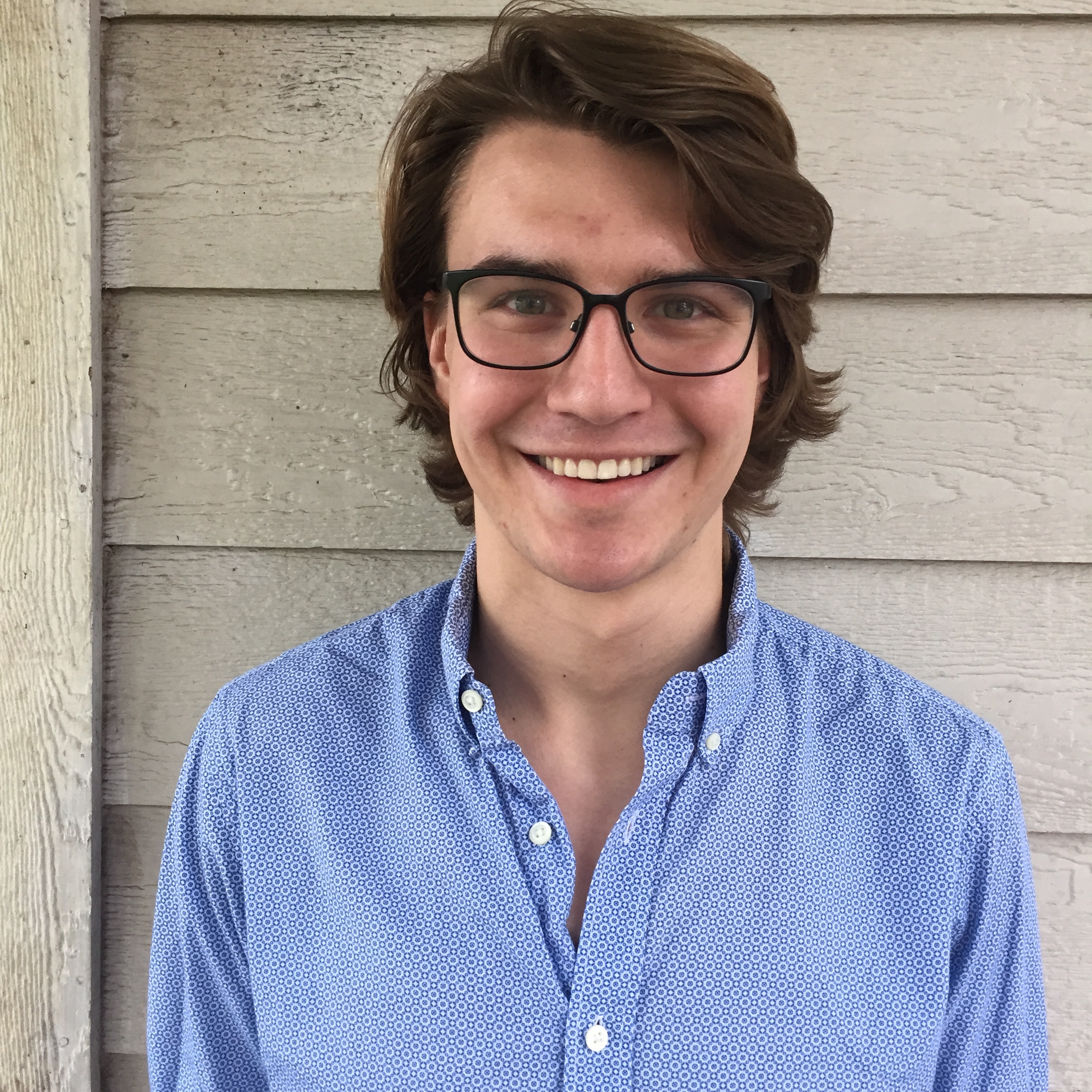
Why NanoJapan?
The NanoJapan Program personifies the idea of international collaboration. As a physics student and more importantly a pupil of the universe, I strive for answers. Unfortunately, not every question can be approached and answered through the vantage point constructed by my personal experiences with nature. Therefore, a separate way to approach a particular problem is required, and international collaboration creates those separate way. Students and researchers in Japan view the world differently than I do, and understanding the reasons why they view the world the way they do will ultimately make me a better scientist; capable of solving problems that I couldn’t solve previously. Characteristics of our universe are cultureless, but the way we come to discovering those characteristics can differ greatly depending on one’s culture. This program is important because it enhances the critical thinking skills of any scientist or engineer.
I chose to apply to this program for multiple reasons. First and foremost, a lot of cutting-edge, technological research takes place in Japan and the opportunity to become a member of a research group on the frontier of this field is an opportunity no physics or engineering student should undermine. I was also attracted to the mysteries and unknowns surrounding the terahertz region of the electromagnetic spectrum. The will and desire to know more is the purpose of my undergraduate education and the reason I study physics. The NanoJapan Program gives students like myself the opportunity to determine whether or not this field of study is something worth pursuing after college, and I look forward to knowing whether or not nanotechnology is my calling as a scientist. Since this research is taking place in Japan, I also look forward to the geographical and cultural differences between Texas and Japan. Japan thrives on making everything very small and compact so that no space is wasted, while Texas wants everyone to know that “everything is bigger in Texas”. Personally witnessing the polarity between the two will be very exciting.
My goals for this summer are to:
My experiences are similar in the fact that Japan is a very successful first world country, much like the United States. Tokyo has very nice roads and Azabu-Juban is a very comfortable place. The language is very well structured, which is what I expected since most languages besides English are. Some of the differences that I’ve noticed are that they don’t drive on the right side of the road, and they are not as confrontational as Americans (Japanese children are an exception). We did have a bon-fire where a lot of Japanese citizens came and ate BBQ with us, and I did get to meet a lot of locals. No one brought matches, but thankfully I brought my mixtape and everything ended up going according to plan. Sumo wrestling was very interesting to watch, but I expected it to be more exciting. There are a lot of ceremonies and introductions, but the fights last roughly 5 seconds each.
Learning the language has been very fun. Memorizing the words can be mundane sometimes, but the satisfaction of being more dynamic with the language makes up for it. I took a semester of Chinese freshman year so I have had the luxury of understanding some of the Kanji, but the biggest strategy I’ve used to help understand Japanese is asking what words mean outside of the language class. We’re constantly in contact with Japanese and local Tokyoites, from KIP students to elementary school children, and that helps to really learn the important words we use in everyday conversation that don’t come up in class. I often try to speak Japanese with these students, and whenever I run into a word I cannot say, they gladly tell me the Japanese equivalent, and I then make a note in my phone for future references.
Question of the Week
One question worth asking is, how does the two polarizing cultures of Japan interact? There’s been a large non-Japanese influence among the younger civilians (ages 30 and below) that does away with a lot of the older traditions that the elders and older adults still abide by. It would be nice to have the opportunity to talk to members of both cultures. From the traditional side, it can be very hard to see a country’s traditional culture slowly fade away. But the younger generations seem to be more progressive and willing to change to traditions more suited for them.
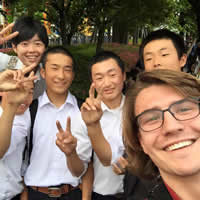
Selfie with some local Tokyo schoolchildren.
Initial Research Project Overview
Unfortunately I haven’t been given a lot of information, but since I am working with Saito Sensei, I will talk about carbon nanotubes. Carbon nanotubes can be either a metal or a semi-conductor, depending on the angle at which the tubes are rotated. Carbon nanotubes are 1-dimensional and have very high tensile strength. Carbon nanotubes are popular because they weigh very little yet still have a very high tensile strength. I do not know the theoretical methods of which I will be using to conduct my research, but I am very eager to learn when I arrive in Sendai. Carbon nanotubes are extremely applicable due to their high strength and low weight, but are now becoming more applicable in electronics due to their ability to be either a metal or a semi-conductor. Saito Sensei said that a computer made of purely carbon nanotubes is currently trying to be made.
While visiting Nagano, the NanoJapan students and myself got to see the side of Japan that is often overshadowed by the very urban and technologically advanced cities. Nagano is a beautiful village surrounded by mountains and parts of Nagano are actually built on the sides of these mountains. Nagano is known for having a lot of onsens, and all of the male NanoJapan students got to sit in an onsen together. Now, (this) onsen was roughly the side of a hot tub, maybe a little larger, and with 8 NanoJapan students plus a few KIP students, it was very crowded. And by the way we were naked. And that wasn’t a big deal at all, until Ajay and I were literally touching each other because the onsen didn’t have enough room for 10+ adults. But by the end we all bonded from the experience, and now whenever we get disappointed in each other, we express that disappointment with a phrase along the lines of “C’mon man! I onsened with you!” We had a blast and that was probably the most humorous experience I had in Nagano, aside from teaching the KIP students about my mixtape at the bonfire.
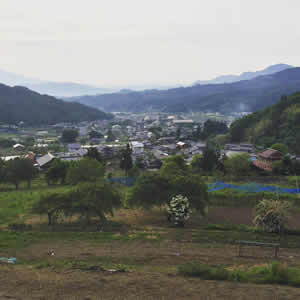
Nagano from above
Nagano was nothing like I expected. I didn’t think Japan has such rural areas given its small size and large population. I learn something new everyday. The town preserves its old and natural beauty, much like my hometown of Fredericksburg, TX, and preserves it well. I didn’t expect a town like Nagano to be a place where people had families since Tokyo wasn’t too far away (Although there are young families in Nagano, the town is dealing with a declining population issue). Since most of the younger Japanese adults live in the urban areas, Nagano is able to keep the traditional Japanese culture, which is something the government should try to protect if they want to better preserve this unique culture. Nagano was nothing like I expected, and I’m very happy that Japan has these very scenic, rural, and mountainous areas.
Interacting with the villagers was very fun! We went to watch this taiko drum performance and even got to try and play the drums ourselves. We each partnered up with a taiko student and got to perform this very cool and energetic routine. My partner’s name was Izuki and she was very shy, but a very good taiko sensei. We met this man named Geo (That may be spelled incorrectly) who was trilingual in Japanese, Spanish and English, and he hung out with us a lot. I really liked him because he possessed aspects from all three cultures, and was able to inform us about the Japanese culture in fluent English. He taught me a lot about Buddhism and Shinto (the Shinto shrines were abundant) and I was able to connect to the traditional Japanese culture a little more after leaving Nagano.
This week, I really progressed in my Japanese language skills. In fact, I accidently left my glasses at the local Starbucks. The next day, I walked into the cafe, told them I lost my glasses, and proceeded to ask if they found them, all in fluent Japanese. They were very impressed. And it gets cooler… they ended up having my glasses! I was so happy and my progress with the language will definitely help in Sendai.
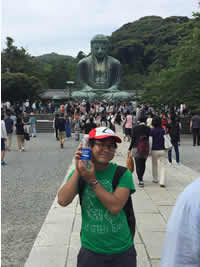
A-Sa- San with his Pocari Sweat, and then some statue in the back (Daibutsu in Kamakura)
Intro to Nanoscience
Dr. Kono’s lectures taught me a lot last week. When I was reading a few of Saito Sensei’s papers, I noticed a lot of information was covered during Dr. Kono’s presentations, and the papers became a lot easier to read. I thought the band gap and k-space diagrams were the most interesting things Dr. Kono talked about, mostly because I actually knew something about those topics. I was able to increase my understanding of the natural world, and that’s all I can ask for sometimes.
Preparation for Research Internship - Article Review
M. Shoufie Ukhtary, Eddwi H. Hasdeo, Ahmad R. T. Nugraha and Riichiro Saito. "Fermi energy-dependence of electromagnetic wave absorption in graphene." Appl. Phys. Express 8 055102 doi:10.7567/APEX.8.055102
I read the paper “Fermi energy-dependence of electromagnetic wave absorption in graphene” and it talks about the ability to change the absorbance percentage of a monolayer of graphene by changing it’s Fermi level and the EM wave’s angle of incidence. An undoped monolayer of graphene has an absorbance percentage of 2.3% and makes a great transparent conductor. The paper talks about its applications in photo detectors, optical antennas, and solar cells, but notes that the current applications remain limited. In this paper, graphene was placed between two dielectrics with separate dielectric constants, and this allowed for total inertial reflection and enhanced EM absorption if the incident wave was on the side of the graphene with the higher dielectric constant. By changing the angle of incidence and the Fermi energy of the graphene, the absorption percentage is shown to vary from 100% to 0%. As the Fermi energy decreases, the absorption percentage decreases (but never goes below 2.3%). An EM switch was theorized to exist when switching the Fermi Energy from a value above .4 eV to 0 eV, and the paper notes the usefulness of this switch. This paper was very interesting because it wasn’t like the theoretical papers I have seen at Texas A&M. This paper was able to talk about applications to the theory and made me more motivated to read the paper. The paper even had an example of a simple system that could easily verify the theoretical results. The conclusion emphasized the parameters (frequency and Fermi Energy) at which the desired results could be achieved and expects the results to be experimentally verified soon.
On public transportation, people are usually quiet. They really do make their settings harmonious, to quote the pre-departure guide. Because they were naturally quiet, we couldn’t be quiet (for some reason). I think Katherine tripped and fell in the train, twice. People sit most of the time but some prefer standing. I personally prefer to stand since there are enough handles and I’m usually too lazy to take my backpack off and find a seat. Given a lot of passengers, I will usually take my backpack off since it’s a borderline weapon when I need to turn around on a crowded train. People don’t do anything on the train, except play on/look at their sumaho (smart phone).
In Japan, men don’t ever give up their seats for women. This was a stark different from Texas A&M, where guys usually offer to give up their seat. A bigger difference I noticed is that taxis are everywhere in Tokyo. I’m sure Manhattan is very similar, but coming from a small town with one taxi company, it was a shocking sight.
Since my time in Japan, I’ve noticed that we abuse the phrase “I’m sorry” or “excuse me”. No one really says it here. In America, people say “I’m sorry/excuse me” for the weirdest things, and I usually get a weird look when saying it to a native speaker for doing something like brushing against them or blocking a small passage.
The transportation system in Japan is very easy and convenient. There’s always a taxi available, and if you want something cheaper and faster, the subway is always an option from 5 AM to midnight. In rural Texas, taxis are unavailable and the only subway is a sandwich shop. Personal transportation by car is the predominant method.
One thing I noticed about the Japanese culture is that the younger generations are a lot like the younger generations in America. We went to this “place” where Japanese college students were having these “drinks”, and they were louder than us. It was actually very shocking to find someone louder than Ajay, but we found plenty. No disrespect to Ajay though. We actually have a mixtape coming out soon. We call ourselves the Bento Boyz. But it was nice to find a culture that I could relate to. They were singing and dancing and having a good time, which is something you would not expect to find in a public setting. There are very clear cultural differences in the Japanese society.
I think my only question this week is… How is Packard Sensei such a powerful woman? It’s almost intimidating. There hasn’t been a thing she couldn’t do.
There was no introduction phase on the first day at Saito lab. After quickly greeting everybody, I went to my office with my mentor and we reviewed the test Saito Sensei sent me prior to arriving at the lab. I really had to hit the ground running but was never out of my comfort zone. At 3 pm that day, I presented the answers to the test via a PowerPoint presentation to Saito Sensei. We did have a takoyaki party on Thursday though! I got to make my own takoyaki and Saito Sensei even referred to me as the “takoyaki master”.
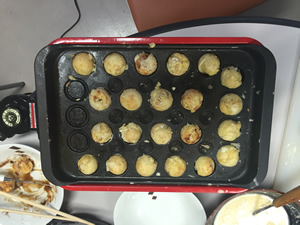
Shoufie-San is my primary mentor in the Saito Lab, although almost every graduate student has helped me in some way so far. Shoufie-San and I get along very well. We laugh about a lot of things and he will sometimes ask my questions in Japanese to help me work on the language as well. Before I present my daily report to Saito Sensei, Shoufie-San and I review the material I need to know, because apparently if I don’t present/know the information well enough, Saito Sensei will call Shoufie-San into his office and get upset with both of us. Thankfully that hasn’t happened (yet)!
Since the language of physics is English, everyone in Saito Lab knows at least a years worth of English. But I usually try to speak in Japanese when I can, although it is hard since physics has such a unique vocabulary. My ability to speak Japanese won’t affect my ability to work effectively. I don’t know how I feel about that though, since I really want to be put out of my comfort zone, and forced to learn the language. I do study the language in my free time though.
The Sendai Squad is spending the summer in a dormitory called “Urban Castle”. It has a kitchen and social areas, and the rooms are twice the size of Sanuki’s. There are a lot of foreign students in the dorm, so during the evening, you can hear several languages being spoken in the lounge. Saito Lab is located in the Aobayama campus, on top of this fairly large hill. I prefer walking up the hill every morning since it gives me time to relax, think, and even work out the glutes! If research doesn’t work out, maybe jean modeling will.
My research project isn’t completely clear, since there are a lot of things I’m currently working on, but I know the general topic of my research. I’ve actually finished my “learning phase” and already have some things to send to Kono Sensei this week regarding his experiments on graphene.
Overview of Orientation Program
The orientation program was good and very informative, although there are some things I would probably change about the language part if I could. We unfortunately never learned how to understand casual talk, and since I’ve been in Sendai, everyone has used casual talk when speaking to me. The verbs conjugate differently so it’s nearly impossible to understand anyone, which was actually very depressing since we had just completed 3 weeks of a very intensive language course and had so comprehension skills to go along with it. But other than that, the orientation was very helpful and I learned a lot about Japan and nanotechnology. The guest speakers were all great and Packard Sensei’s lectures were always interesting. I’ve been able to avoid some potentially bad scenario’s because of the orientation.
My Japanese studies have been going well since Tokyo. The graduate students are always willing to help me and answer my questions. Since Tokyo, I’ve learned new phrases, conjugations, and vocabulary. I hope to learn enough conversational Japanese to receive some kind of credit at the end of the summer. I try to talk to the KIP students in Japanese whenever I get the chance. Prior to Japan, I knew nearly no kanji. But through immersion, I’ve been able to learn or at least recognize the important characters and their meaning. It’s saved me from accidently going into the woman’s restrooms, going into restricted areas, and has even been great for finding the karaoke places!
NanoJapan Research Project Update
My project includes finding a way to increase the electric fields across a single layer of graphene so the absorbance can reach levels close to 100%. A paper was previously published at Saito Lab showing it can be done without the increased electric field, but Kono Sensei’s experiments have shown that the graphene properties used in the paper are unobtainable.
Since Saito Lab is completely theory based, the only equipment I have is my laptop and Mathematica. When I think of a method to solve my problem, I’ll let everyone know.
I’ve worked extensively with drude conductivity along with replications of experimental data to become comfortable with the subject. Saito Sensei even told me I was moving too fast, so now I proof read everyone’s unpublished papers since no one is completely fluent in English.
When I first arrived to Sendai, there was one experience I had with a Starbucks barista that didn’t go according to plan. It’s sort of ironic because Starbucks is the one place where communicating and speaking english isn’t really a problem, but I tried to be a hero and it didn’t go well in the end. When my drink was called, I took it and tried to say something in Japanese along the lines of “that’s pretty” because they wrote “thank you” with a smiley face next to it. But what ended up happening is that accidently said “distasteful”, the two words are “kirei” for pretty, and “kirai” for distasteful. I meant to say “kirei” but my “I’ sounded too much like an “a” apparently, and yea they were not happy. I realized I had messed up when the lady started to raise her voice. But I figured I had messed up and I then told them that I didn’t understand Japanese, “nihongo wakarimasen”, and everything became innocent again. After that moment she became a lot friendlier and obviously knew I was practicing my Japanese. She saw the good intentions and was able to have a nice laugh over what I said. Next time I should verify the pronunciation, because there are a lot of words that sound a lot like a word of the opposite meaning.
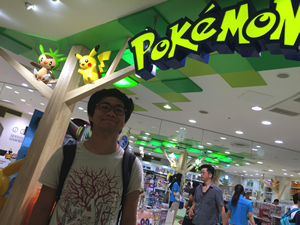
My research has gone very well so far. I’ve actually already completed the NanoJapan project I was assigned, and I now work on a separate project at Saito Lab. My NanoJapan project was to find a way to get impure graphene to absorb a high percentage of light. One of the students, Shoufie-San, is doing his master’s thesis over the subject. He was able to theorize that 100% absorption is possible within certain parameters, but when Kono Sensei tried to verify his theory, it was not possible because the theorized graphene was way to pure. The problem I was given was to try and find a way to increase the absorbance to roughly 100%. When looking through the papers and building my own theory, I noticed that they never took into account that Fermi-energy could be a variable. They had always assigned a value but never made their absorbance function a function with respect to the Fermi-energy. Once I found the parameters and made the function, I was able to see that 100% absorbance was possible at higher Fermi-energies even when using the impure graphene. My results have been sent to Kono Sensei and his lab is currently setting up the experiment to verify if my theory is correct. Hopefully we see some positive results! Here are some of the plots I was able to get.
My biggest personal accomplishment thus far has been gaining the acceptance of my fellow lab mates. They have really included me in everything and they truly see me as an equal. I think they see me this way because of the effort I’ve put into learning what their master thesis’ are about, and the effort I’ve put into learning Japanese/correcting their English. We always get lunch together at the cafeteria and use that time to talk about our lives and what we did to get to where we are today.
The biggest personal challenge has been learning Japanese in real settings. Often times, they speak way too fast, and comprehension is impossible other than particles or sentence ending words. What makes it worse is when I try to ask them to repeat what they said, or to say it slower, they usually just say one or two words in English that give away what they’re trying to say, and my Japanese is never used.
My research has been going great. I finished my NanoJapan project a few weeks ago so now I work on auxiliary projects or help the graduate students with the wording of their papers. Currently, I’m working with layered dielectric materials and constructing a way to build up the electric fields within one of the layers via constant reflection within that medium. I love it because it’s theory, so I don’t have the problem of waiting for lab time, or waiting for a machine to get fixed. I also love it because I can apply a lot of the mathematics I’ve learned in college. I did a lot of linear algebra from a purely mathematical standpoint, so the matrices I create at Saito Lab are very comfortable to work with because I know their foundation as a mathematician, but I also know the application and what it really represents because of my knowledge in physics. Thankfully, I don’t there are any issues at the lab. I was fairly sick last week for about 2 days, but it’s gone now and Saito Sensei wasn’t even in Sendai so there was no serious lack of knowledge due to my illness. There isn’t anything I feel I need to discuss at the mid-term meeting. It seems my research experience has been smooth sailing compared to a lot of the other students. I don’t know what to say about my research experience anymore. I haven’t had any setbacks or accomplishments because I’m done with my research part (unless Kono lab cannot confirm my theory).
I’ve been very adamant about learning Japanese since I left Tokyo. After orientation, I knew enough of the language to tell somebody very basic sentences, but I couldn’t hold a conversation with a native speaker. Now I can make out certain words in a sentence if somebody is talking to me, and although I may not understand the question completely, context and inferences usually give me enough information to construct a response. I study Japanese by talking to lab mates in Japanese or texting the KIP students. I try to speak solely Japanese when talking to the KIP students, and they obviously use Kanji I haven’t seen before, so I’ll look up the word, save it on my phone, and then study the word later. I think this method is best so far, along with self-studying, because I can analyze a native Japanese speakers language and notice certain sentence structures. I wish I had more time to work on verbal comprehension though. I can understand the kanji a lot faster than I can understand the spoken language, because there aren’t many opportunities to learn other than the TV or eavesdropping on near-by conversations, and I can’t really ask questions during those times. But other than that I don’t have a very hard time linguistically. I can get around town easily now. The kanji helps a lot (go figure).
I would love to take the time to become fluent in Japanese, although a double major in physics and mathematics doesn’t allot much free time. I’ve considered studying Japanese in Japan for a year, and only taking intensive Japanese courses plus a few electives. I’ve already found one program I might be interested in. I believe understanding a language allows you to see the world from a separate perspective, and I would really love to live in Tokyo someday. But since I cannot stay in Japan, and I cannot take the actual Japanese courses taught at my school, I figure that self-study, getting involved in a Japanese club at school, and maintaining contact with the KIP students should suffice until I find a way to rigorously learn Japanese. I’m deathly afraid of loosing what Japanese I have been able to retain once we return to America. The language is not easy!
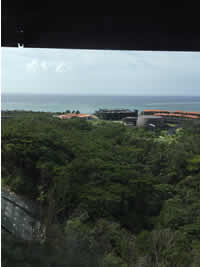
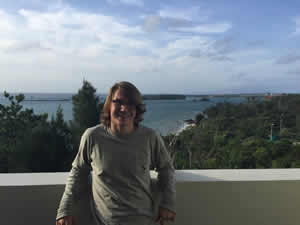
View of the Okinawa Institute of Science & Technology Graduate University
OIST was a great experience. We were treated with such great hospitality and even with the humidity, I’m still interesting in interning there. The Ph.D. program seems fantastic. They really do want interdisciplinary research, and that’s a new type of research that I would love to do. Along with the research, the incentives to get my Ph.D. or conduct research at OIST are incomparable. They really look out for their students. After the conference, I’ve realized how much I love theoretical physics more than experimental research. It seemed like everybody but Steven and I were having technical difficulties with their experimental devices, and I feel like that can really take the fun away from the problem solving aspect. It certainly takes away from the mathematical proofs I love to do. I may even get my Ph.D. in theoretical physics, since I’ve grown so fond of the mathematics.
At Saito Lab, there haven’t been many “rules” that affect the way people act. I can always go to Saito Sensei or any of the graduate students for help whenever I need it. I think this is a luxury most students don’t have. In the lab, we always say –San and –Sensei, but sometimes that’s the only formal part of our interactions (unless it’s Saito Sensei). When we disagree, I usually assume I am wrong, since I’m the youngest and the most inexperienced. I don’t often listen to other students discuss disagreements since I have my own office, so I cannot speak about the disagreements between two graduate students.
The experiences I was told to expect are more or less the same. During the orientation program, the humbleness of Japanese people is something that I have really seen a lot. It’s almost a form of hustling if it’s something competitive.
In terms of academic research in the field of physics, nothing really differs from the way we conduct research in America. Physics is cultureless, and a lot of the professors have actually visited American universities, so the research part is completely the same. Both value hard work and long hours too.
I haven’t actually worked in an American lab. I’ve only talked to researchers and done a few problems for them, but I’ve never actually worked in an American lab. But with that being said, I think I would prefer the Japanese lab because they love having a native English speaker to critique their work. It’s interesting having these professors come to me for advice.
In Saito Lab, I haven’t had many rules that anyone would find abnormal. But I was told not to be as sarcastic, because sarcasm isn’t understood in Japan. My mentor understands sarcasm, but no one else does, so he always shushes me when I say something sarcastic. So that’s the one rule I’ve have had to conform to.
Research Project Update
This week, I’ve finished my calculations and program for a double graphene system. I have three separate mediums, with graphene at the boundaries, and am currently finding the optimal settings to achieve 95%+ absorption. Achieving 95%+ isn’t too difficult, but doing so with the easiest conditions requires a lot more calculations.
I did encounter a few difficulties last week when constructing my matrices. The material was fairly new to me, as I have only proven things about matrices. So I had to talk to Shoufie-san (my mentor) a lot about the mathematics and it wasn’t until yesterday that I was able to finish the construction.
For my interview, I interviewed my mentor, Shoufie San. Shoufie San was born in raised in Indonesia and came to Tohoku University as a graduate student in Saito Sensei’s lab. He studied physics and chose physics because was good at it and wanted to learn more about the world. I really enjoy having Shoufie San as my mentor because he always there to help me and guide me down the path of success, which I’ve have come to realize is a luxury here in the NanoJapan community. His views on research, and the way it should be conducted, are much like my own views. He understands the crucial role of how both science and the way science is conducted in life. He said that science is unique because it doesn’t care about opinions, or how one feels. The way science is conduced allows for multiple students to express their ideas, and allows for a pupil to tell his superior, “I believe you are wrong, and this is why…”. Unfortunately though, I have heard that many Japanese labs reject that way of conducting science. Saito Lab is not one of those, as I have personally challenged the findings of multiple students, only to have them politely show where I was confused. Shoufie San said that Saito Lab harbors individualism, and really allows him to be who he is as a scientist.
Shoufie San also loves how international Saito Lab is. First, English is the predominant language, and so Shoufie San has become an international scientist, due to his ability to refine his English in the lab and in his personal talks with me. Secondly, we have so many cultures in the lab that we’ve been able to learn a lot about human geography and anthropology alongside our scientific studies. During our interview, we actually pulled out Google Maps and showed each other our homes towns. It was very nice to see where he went to school, where he lived, and then able to show him how different the Texas hill country is. Our different upbringings allowed for a lot of dialogue and bonding.
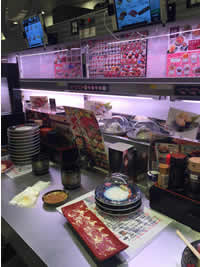
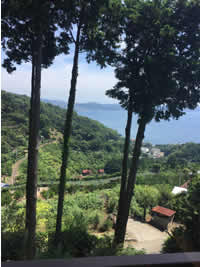
Week 9 Photos
Research Project Update
My research has come to an end, as I found my results and Saito Sensei has left for America. Now I’m working on writing a paper over my results with Shoufie San. I really enjoy having time with him one-on-one to hone my technical writing skills. The Saito Lab has been so great to me. I couldn’t have imagined being at any other lab with any other students.
From the articles that I’ve read about the Obokata controversy, I think Obokata did a very bad thing. Lying about her data, and fabricating her results to the levels that she did is extremely unethical. As far as gender issues go, the fact that she was a woman did unfortunately have a negative impact on women in academia and research. There is no specific impact that I can think about, but this controversy is obviously not a good thing. It was far too big of a research paper to not have some sort of influence, so I believe it did promote the negative stigma that women currently have in STEM. But what happened to her was not due to the fact that she was a woman. Science needs to be challenged and questioned. Your research needs to be replicable, and people need more proof other than word of mouth. It’s a shame that her gender was brought into the scenario, but bold face lying in a paper over breakthrough advancements in stem cell research deserves condemnation. The fact that she was a woman should not be condemned.
I cannot comment much on gender issues in Japanese research, because my lab only had male students. And I have never done research in a lab before, so my viewpoints have no foundation. But I think the gender issues and stigmas in Japan are very similar to the issues and stigmas in America. Both countries appear to have a glass ceiling for women as far as their career is concerned.
In Japan, I wasn’t able to observe blatant sexism. Probably due to the fact that I cannot understand the language, and I don’t work in Japan. I think there is arguably more sexism in America, but again, I attest that to the face that I understand English and I study at an American university. I see much more “cat calling” in the United States. But both America and Japan seem to treat women and men the same, as long as we ignore the sexism against women in the workforce, and the sexism against men in the legal system.
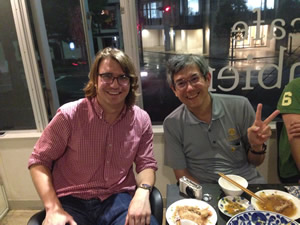
Cole Reynolds with Prof. Saito
Since being in Japan, my perceptions and attitudes towards the nation have really amplified. I really admire how nice the people are, and how they cope with a lot of people in their country not being able to understand Japanese. In the United States, I notice how overweight some people really are. Coming from a country where nearly everyone is a healthy weight, it’s kind of sad to see so many unhealthy Americans (or at least in Texas).
Looking back on my personality before I left for Japan, I would say I’ve become a more humble American (and a little more depressed since I’m not in Japan!). Being away from a very nationalistic community (Texas) has shown me that we should probably get down from our high horse. I love America, but we love to boast about every accomplishment, and throughout the NanoJapan program, I noticed how our conversations morphed from being about the individual, to being about the group, and that was very comforting to me. The Japanese are very humble individuals, and they never accept any compliments you may want to give them. I think some of that rubbed off onto all of us.
The most common daily frustrations, personally, is how little I was able to use my Japanese. It’s kind of unfortunate, but English speakers have a very difficult time learning a foreign language. English is everywhere, so we’re never truly submerged into this foreign language because every sign and every major area will have English words or English speakers. We never truly have this motive to really study because we know we can succeed in Japan without really any Japanese.
The biggest thing I’ll miss about Japan will be the friends I made, and Tokyo. I keep in touch with a few Japanese friends, so I’m not completely disconnected from them, but Tokyo is a place I unfortunately cannot find anywhere else. The cleanliness and safety is something very unique to a city that large. A girl can walk downtown at 10:30 at night and not have to worry about a single thing, and she won’t find trash on the side of the road as she walks either. I cannot imagine either of those being present at any major U.S. city.
After finishing this program, I have realized that I do love theoretical research. I love letting my mind go crazy with ideas and then trying to figure out which ones will help solve my current problem. And because it’s theory, I can incorporate the knowledge I’ve gained from my mathematical studies to help me solve problems. I will almost certainly strive for a Ph. D. in either theoretical physics or applied mathematics.
The last week in my lab was fairly boring, since all of the festivities happened the week before. Saito Sensei had made previous arrangements before the program to visit Boston for 3 weeks, so we had to have my farewell party very early. But I made sure to thank everyone in the lab, because I couldn’t have learned as much as I did without the constant aid of the master students (especially Shoufie San) and Saito Sensei. They really took the time to sit down and teach me everything I needed to know, and they even test me over the information via PowerPoint presentations every day for the first few weeks.
I have been in contact with both Saito Sensei and Shoufie San since my arrival to Texas. I was able to obtain good results in Japan, and we have decided to publish a paper on those results, so that requires a lot of back and forth communication. We also use that time to catch up and chit-chat.
The last weekend in Japan was spent with all of us hanging out in Azabu Juban. We spent a lot of time talking about the second half of our research experience in the Sanuki Club’s conference room, and we also worked on our posters (which we almost all procrastinated on). We spend the last few hours before we left for the airport with Packard Sensei. We went out to lunch with her and then took some pictures in the Sanuki lobby. She was such a big help to the students and the people in charge of the NanoJapan program.
When speaking to a family member, I would tell them that learning Japanese and making Japanese friends were the most important things I learned from NanoJapan, since they probably won’t understand the scientific and technological side of the NanoJapan program. I’ve really gained an appreciation for foreign languages while I was out of the United States, and I think knowing a foreign language allows you to view the world from that culture’s perspective. Unfortunately, it’s incredibly hard to learn a foreign language in the United States. While in Sendai, we spent a lot of time with European students, and I felt so bad when they asked us, “what other languages can you speak?” because we don’t have the opportunity to learn other languages. In Europe, they’re only a few hours away from several other countries with their own native languages. But in America, the only neighboring country with a separate language is Mexico, and with the border security and the crime associated with that country, it is very hard to visit at whim. Thankfully in Texas, we have the opportunity to learn Spanish fairly easily due to the large amounts of Spanish-speaking Americans. But having the ability to speak a little bit of a language as foreign as Japanese has really opened my eyes to how different other humans think and go about their lives. I was also able to befriend several Japanese friends, and having them to talk to allows me to somewhat stay connected to that different lifestyle. Maybe if I ever travel to Japan again, I can visit with those friends again and catch up where we left off. I think having friends all over the world is just a really cool thing, and it can open up a lot of doors and lead to some great adventures and opportunities.
I have actually already spoken to a professor since the NanoJapan program. His name is Alexey Belyanin and is actually a member of the terahertz/nanotechnology theorist group with Dr. Stanton and Saito Sensei. I was told by Dr. Kono and Dr. Stanton to introduce myself to Dr. Belyanin, and I ended up having a very good discussion with him. I ended up asking if I could possibly do some research with him next semester, and because I was a NanoJapan student, I was able to tell him about the physics I was introduced to this summer and why I would be a successful member of his research group. The most important things I learned were how to be an independent researcher and how to conduct theoretical research relating to graphene and terahertz radiation. He said he doesn’t normally accept undergraduates into his research group, but that I would be able to join as an undergraduate because I was a NanoJapan student and know a lot about this type of physics. When speaking to Dr. Belyanin, the ability to conduct my own research and the opportunity to learn from very successful researchers were the most important things I learned from the NanoJapan program.
When speaking to an employer, I would tell them that the ability to adapt and immediately start learning in a foreign environment is the most important thing I learned from NanoJapan. But I realized that it takes a lot to successfully adapt in a foreign environment. I had to determine the personalities of my fellow co-workers and remain very wary of the cultural “dos and don’ts” in the work place. Once I felt that I had a grasp of how the Japanese culture differs from my personal culture, I was able to befriend everyone in my lab, including my “very strict” professor Saito Sensei, whom I thought had a greater sense of humor than I did and didn’t seem strict at all. But the exposure to an environment so different than my own was very important, and the help that the NanoJapan program gave me to succeed was even more important. The pre-departure meetings at Rice University and the scientific/cultural talks in Tokyo gave me enough information and heads-up to walk into my lab with confidence.
When speaking to a student, the research aspect of the NanoJapan immediately jumps out as the most important part. Another major incentive would be that the research is conducted in Japan, so you end up studying abroad as well. What makes this REU so great is that we’re conducting research over nanotechnology, and we’re doing this in Japan. Japan has always been praised as a beacon for copious technological innovations. The knowledge a student could embrace by studying and doing research at a Japanese university is astronomical. Not only would that student learn more about science and the impact nanotechnology has made and continues to make throughout the world, the student would also gain anthropological knowledge by viewing the world through a separate cultural lens.
This program also gives young college students a very smooth transition into the research side of academia. I’ve heard that a lot of other REUs don’t really help out the students as much, and they have to hit the ground running. I think that can be very intimidating for young researchers, and might end up deterring them from pursuing a career in research if their experience with their REU was bad.
After participating in the NanoJapan program, I will definitely be looking for international research opportunities for next summer. I might even try to take a year off and study the Japanese language at a university in Japan (I still cannot get over how different their language is compared to English). It would be nice to visit my Japanese friends again, and maybe even see some of the NanoJapan students! I know Steven was interested in the University of Tokyo’s UTRIP program, so hopefully I can convince Arthur to apply and then maybe the Sendai Squad can have a reunion if we all get accepted.
One question I have about Japan is why most Japanese citizens aren’t interested in politics. I’ve asked several Japanese students this question and they think it’s because they’re shy people. One of our friends from the University of Tokyo told me that her sister didn’t even know how to spell the prime minister’s name in kanji. It’s interesting that in a country as successful as Japan, citizens aren’t as concerned with the political working of the nation, but with the new interpretation of Article 7 (the article in Japan’s constitution regarding its militaristic capabilities), hopefully people start talking more. We saw a lot of people in Sendai protesting Article 7’s new interpretation that allows Japan’s military to become more offensive and potentially more aggressive. The Japanese people appeared to prefer the idea of isolationism, so hopefully that encourages more people to give their opinions on big decisions in the future. I know it was hard for us to talk about politics in Japan, and actually when we returned to America, all we did was talk politics. One morning at breakfast, an old lady overheard us talking about the political candidates for the 2016 election, and ended up joining in on the conversation. I guess she thought our generation didn’t care about politics, because she kept on telling us how we restored her faith in young Americans because we did care about the election.